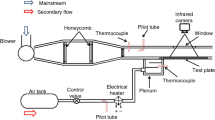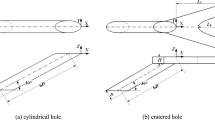Abstract
Results of an experimental study of flat-plate film cooling effectiveness achieved with an inlet double jet scheme are reported. At low (m = 0.5) and medium (m = 1.0) blowing ratio the average film cooling effectiveness is about 20 % greater of the traditional two-row scheme of round holes data, while at higher m = 1.5 it is close to it. The free-stream turbulence (≈ 7 %) influences weekly on the average flat-plate film cooling effectiveness. The flow acceleration decreases the film cooling effectiveness down to 25 % when the pressure gradient parameter K is ranged from 0.5·10−6 to 3.5·10−6.
Similar content being viewed by others
References
R.J. Goldstein, E.R.G. Eckert, and F. Borggraf, Effects of hole geometry and density on three-dimensional film cooling, Int. J. Heat and Mass Transfer, 1974, Vol. 17, No. 5, P. 595–607.
W.F. Colban, K.A. Thole, and D.A. Bogard, A film-cooling correlation for shaped holes on a flat-plate surface, ASME J. Turbomachinery, 2011, Vol. 133, No. 1, P. 011002-1–011002-11.
D.H. Leedom and S. Acharya, Large eddy simulations of film cooling flow fields from cylindrical and shaped holes, ASME Paper GT2008-51009, [CD-ROM].
K. Kusterer, A. Elyas, D. Bohn, T. Sugimoto, R. Tanaka, and M. Kazari, Film cooling effectiveness comparison between shaped- and double jet film cooling holes in a row arrangement, ASME Paper GT2010-22604. [CDROM].
K. Kusterer, A. Elyas, D. Bohn, T. Sugimoto, R. Tanaka, and M. Kazari, Experimental and numerical investigations of the double-jet film cooling technology, J. Energy and Power Engng, 2010, Vol. 4, No. 9, P. 16–25.
E.P. Volchkov, Near-wall film cooling, Nauka, Novosibirsk, 1983.
S. Baheri, B.A. Jubran, S.P. Alavi Tabrizi, The effect of turbulence intensity on film cooling of gas turbine blade from trenched shaped holes, ASME Paper GT2008-50318, [CD-ROM].
E.P. Dyban and E.Ya. Epik, Heat Transfer and Hydrodynamics of Turbulized Flows, Naukova Dumka, Kyiv, 1985.
J. Dittmar, A. Schulz, and S. Wittig, Assessment of various film cooling configurations including shaped and compound angle holes based on large scale experiments, ASME J. Turbomachinery, 2003, Vol. 125, No. 1, P. 57–64.
Z. Gao, Experimental investigation of film cooling effectiveness on gas turbine blades, PhD Disseration, Texas A&M University, 2007.
Author information
Authors and Affiliations
Corresponding author
Rights and permissions
About this article
Cite this article
Khalatov, A.A., Borisov, I.I., Dashevsky, Y.J. et al. Flat-plate film cooling from a double jet holes: influence of free-stream turbulence and flow acceleration. Thermophys. Aeromech. 21, 545–552 (2014). https://doi.org/10.1134/S0869864314050023
Received:
Published:
Issue Date:
DOI: https://doi.org/10.1134/S0869864314050023




